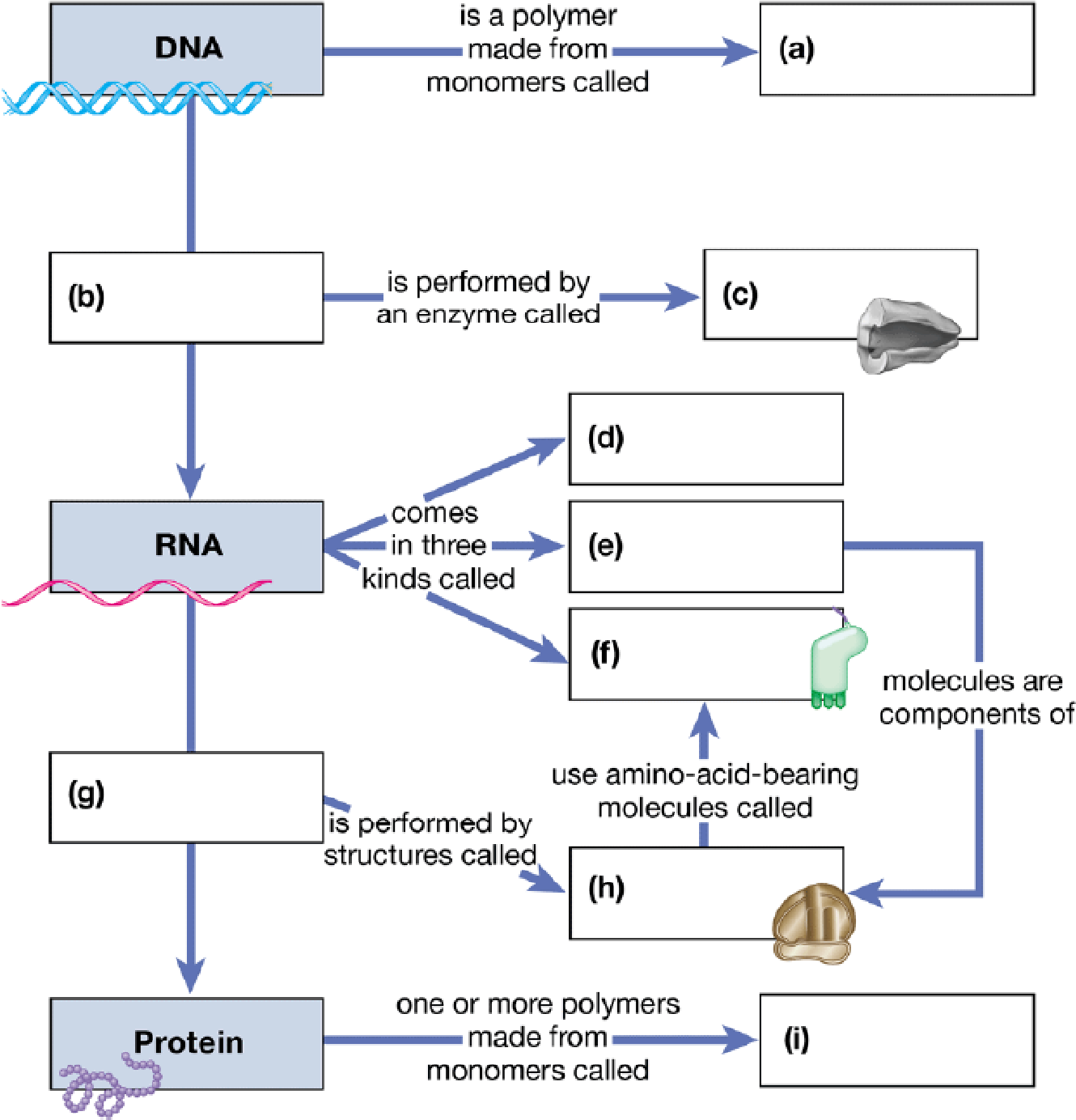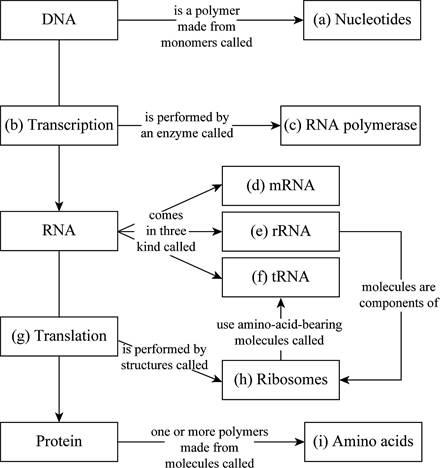
Concept explainers
Check your understanding of the flow of genetic information through a cell by filling in the blanks.

To complete: The given map showing the flow of genetic information through a cell.
Introduction: DNA is the blueprint of life. The genetic information of DNA is based in the nucleotide base sequences. These sequences are transcribed into mRNA triplets. These triplets of nucleotides are known as codons and they form the genetic code. They code for specific amino acids for the synthesis of proteins is known as functional gene products. This is known as gene expression.
Answer to Problem 1CC
Pictorial representation: Fig. 1 shows the completed map of flow of genetic information through a cell.

Fig.1 Flow of genetic information through a cell
Explanation of Solution
(a)
Correct answer: Nucleotides.
Explanation: The nucleotides are the building blocks of nucleic acids (DNA and RNA). DNA is a polymer made up of nucleotide monomers (adenine, thymine, cytosine, and guanine) and also known as polynucleotide. Hence, the correct answer is nucleotides.
(b)
Correct answer: Transcription.
Explanation: DNA consists of genetic instructions in the form of nucleotide sequences. It acts as a template and directs the messenger RNA (mRNA) synthesis in the cell. The process of formation of mRNA is known as transcription. Hence, the correct answer is transcription.
(c)
Correct answer: RNA polymerase.
Explanation: RNA polymerase enzymes are of three types out of which, RNA pol II transcribes mRNA. RNA pol II enzyme first binds to the transcription factors and then forms a complex with promoter at start codon for the beginning of transcription process. Hence, the correct answer is RNA polymerase.
(d)
Correct answer: mRNA.
Explanation: Both prokaryotes and eukaryotes consist of three types of RNA: mRNA, rRNA, and tRNA. mRNA forms 5% of the total RNA in a cell. mRNA consists of the genetic code in the form of triplets of nucleotides known as codons. Hence, the correct answer is mRNA.
(e)
Correct answer: rRNA
Explanation: rRNA forms 80% of the total RNA and is found in ribosomes. rRNAs along with proteins form ribosomes, which act as a site for protein synthesis. Hence, the correct answer is rRNA.
(f)
Correct answer: tRNA
Explanation: tRNAs are smallest among the three types of RNA. The mRNA sequence is read by transfer RNAs (tRNAs) to form polypeptide or a chain of amino acids in a process known as translation. The tRNA molecule with an attached amino acid binds to its specific mRNA codon. This mRNA codon codes for that specific amino acid. Hence, the correct answer is tRNA.
(g)
Correct answer: Translation.
Explanation: The mRNA acts as a template for the synthesis of polypeptide chain. Each letter in the gene sequence is copied which codes for a particular amino acid. The polypeptide chain is synthesized on the basis of amino acid sequences in the reading frame. This process is known as translation. Hence, the correct answer is translation.
(h)
Correct answer: Ribosomes.
Explanation: rRNAs along with proteins form ribosomes. Ribosomes act as a site of protein synthesis, that is, translation. Hence, the correct answer is ribosomes.
(i)
Correct answer: Amino acids.
Explanation: Amino acids are the monomer units of proteins. Amino acids are linked through peptide bonds to form a long polypeptide chain. Hence, the correct answer is amino acids.
Want to see more full solutions like this?
Chapter 10 Solutions
CAMPBELL BIO: CONCEPTS&CONNECTIONS (LL)
- This question has multiple parts (A, B & C), and under the subject of Nutrition. Thank you!arrow_forwardCalculate the CFU/ml of a urine sample if 138 E. coli colonies were counted on a Nutrient Agar Plate when0.5 mls were plated on the NA plate from a 10-9 dilution tube. You must highlight and express your answerin scientific notatioarrow_forwardDon't copy off the other answer if there is anyarrow_forward
- Use the following information to answer the question(s) below. Martin Wikelski and L. Michael Romero (Body size, performance and fitness in Galápagos marine iguanas, Integrative and Comparative Biology 43 [2003]:376-86) measured the snout-to-vent (anus) length of Galápagos marine iguanas and observed the percent survival of different-sized animals, all of the same age. The graph shows the log snout-vent length (SVL, a measure of overall body size) plotted against the percent survival of these different size classes for males and females. Survival (%) 100- 80- 60- 40- 20- 0+ 1.9 T 2 2.1 2.2 2.3 2.4 2.5 2.6 2.7 Log SVL (mm) 19) Examine the figure above. What type of selection for body size appears to be occurring in these marine iguanas? A) directional selection B) stabilizing selection C) disruptive selection D) You cannot determine the type of selection from the above information. 3arrow_forward24) Use the following information to answer the question below. Researchers studying a small milkweed population note that some plants produce a toxin and other plants do not. They identify the gene responsible for toxin production. The dominant allele (T) codes for an enzyme that makes the toxin, and the recessive allele (t) codes for a nonfunctional enzyme that cannot produce the toxin. Heterozygotes produce an intermediate amount of toxin. The genotypes of all individuals in the population are determined (see table) and used to determine the actual allele frequencies in the population. TT 0.49 Tt 0.42 tt 0.09 Refer to the table above. Is this population in Hardy-Weinberg equilibrium? A) Yes. C) No; there are more homozygotes than expected. B) No; there are more heterozygotes than expected. D) It is impossible to tell.arrow_forward30) A B CDEFG Refer to the accompanying figure. Which of the following forms a monophyletic group? A) A, B, C, and D B) C and D C) D, E, and F D) E, F, and Garrow_forward
 Biology (MindTap Course List)BiologyISBN:9781337392938Author:Eldra Solomon, Charles Martin, Diana W. Martin, Linda R. BergPublisher:Cengage Learning
Biology (MindTap Course List)BiologyISBN:9781337392938Author:Eldra Solomon, Charles Martin, Diana W. Martin, Linda R. BergPublisher:Cengage Learning
 Human Biology (MindTap Course List)BiologyISBN:9781305112100Author:Cecie Starr, Beverly McMillanPublisher:Cengage Learning
Human Biology (MindTap Course List)BiologyISBN:9781305112100Author:Cecie Starr, Beverly McMillanPublisher:Cengage Learning Biology Today and Tomorrow without Physiology (Mi...BiologyISBN:9781305117396Author:Cecie Starr, Christine Evers, Lisa StarrPublisher:Cengage Learning
Biology Today and Tomorrow without Physiology (Mi...BiologyISBN:9781305117396Author:Cecie Starr, Christine Evers, Lisa StarrPublisher:Cengage Learning Human Heredity: Principles and Issues (MindTap Co...BiologyISBN:9781305251052Author:Michael CummingsPublisher:Cengage Learning
Human Heredity: Principles and Issues (MindTap Co...BiologyISBN:9781305251052Author:Michael CummingsPublisher:Cengage Learning





